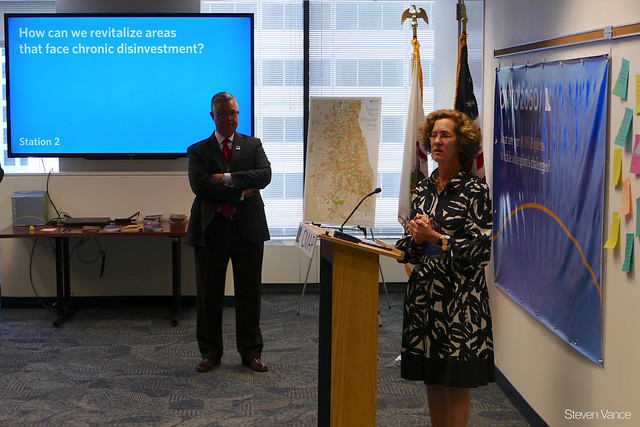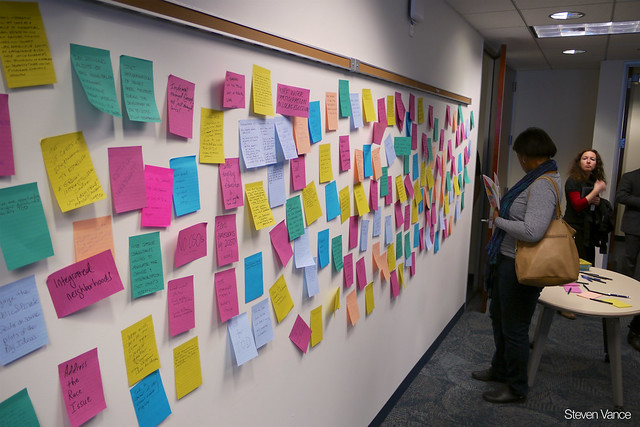
This is part one of a two-part series about ON TO 2050, the new comprehensive regional plan for Chicagoland.
The official planning agency for the Chicagoland region is looking for your big ideas on what the region should look like – and how it could get there – in 2050. The Chicago Metropolitan Agency for Planning is drawing up a new plan to succeed the GO TO 2040 plan, which was released in 2010 after being unanimously approved by 284 municipalities. The next plan, called ON TO 2050, will be released in late 2018 or early 2019.
The federal government requires every urbanized area of 50,000 or more inhabitants to create a regional plan. At its core, the purpose of Chicago's regional plan is to serve as a guide for how to generate and spend public transportation funds.
For example, since Chicagoland is a non-attainment region for air quality goals, CMAP can only spend federal Congestion Mitigation and Air Quality Improvement program funds on projects if CMAP's analysis finds that they would reduce air pollution. While CMAP has approved many CMAQ grants for sustainable transportation projects, unfortunately they've also awarded these funds to intersection widening projects, since these are believed to reduce idling and emissions.
This time around, though, CMAP wants to tweak the planning process. First, they want more community input. Local TV personality Geoffrey Baer, who has made documentaries the Chicago River and the city's boulevard system, recently previewed the planning process on WTTW's Chicago Tonight program two weeks ago. "This is the start of a process," he said. "CMAP doesn't have all the answers, and they don't even have the questions."
Last Wednesday CMAP hosted a launch event for the community input process at their office in the Sears Tower. "We want to reach into communities that aren't typically represented, and translate the planning process to make sense to those who are affected by it," said plan outreach coordinator Jane Grover, a former Evanston alder, during the presentation. "We want to find a good way to bring planning to life, and make it a reality." Grover said she wants to involve high school students and chambers of commerce.
Grover said that they are talking to Chicago community groups and nonprofits organizations like Resident Association of Greater Englewood (RAGE), Garfield Park Community Council, Austin Together, and Slow Roll Chicago. They're also reaching out to leaders in many suburbs. She said that an official from Lake County complained "We can't get talent to live here, or commute here."
I've heard people say similar things about transportation access to Lake County, as well as southern Cook County. Infrequent reverse-commute Metra service to these areas can mean one would have to arrive to work an hour early, or show up 30 minutes late. More frequent service and more flexible work schedules are two possible solutions.
In addition to involving more people and community organizations, and expanding and updating research from GO TO 2040, CMAP is also trying to make ON TO 2050 more specific. Nine new focus areas are listed on the CMAP website. The site notes that the CMAP Board and staff have identified a number of priorities for the new plan. These include creating specific strategies for making our region more livable and resilient, clarifying funding needs by clearly stating costs and funding availability, and establishing measurable objectives.
Liz Schuh, a principal policy analyst at CMAP and ON TO 2050 co-manager, described some of the challenges that persist after the original plan's creation and ongoing implementation. "We as a region are not recovering from the recession as well as our peers," she said. "Our population growth and economic growth are not high as our peers." The Metropolitan Planning Council has detailed this issue in multiple articles on its website.

Schuh said that there has been good progress in freight planning and funding in the region, and the Illinois Department of Transportation has adopted performance-based measures to decide funding priorities. These improvements were recommended in GO TO 2040.
The new planning process also includes writing strategy papers. These are essentially position papers where CMAP planners have done some general research on a topic and are developing a potential direction the agency should instill in the plan. Each one will be posted online when it's complete, and the topics are listed on CMAP's website. Each one also has a topic-focused questionnaire that CMAP planners want residents, employers, and community representatives, to complete.
The Transit Modernization strategy page, for example, asks "What aspects of transit system in other cities would you like to see here?" That's a topic we often discuss in Streetsblog Chicago posts.
Grover, the outreach coordinator, said that CMAP will conduct a workshop for organizations that wants to involve its members in regional planning, and train organization staff to lead workshops themselves. You can contact her through the CMAP website to request the workshop.
Tomorrow I'll discuss some of the policies and recommendations from GO TO 2040 that haven't worked out so well, and how learning from that experience can improve the GO TO 2050 planning process.
Updated March 9 to correct a quote attribution. It belonged to Jane Grover.



